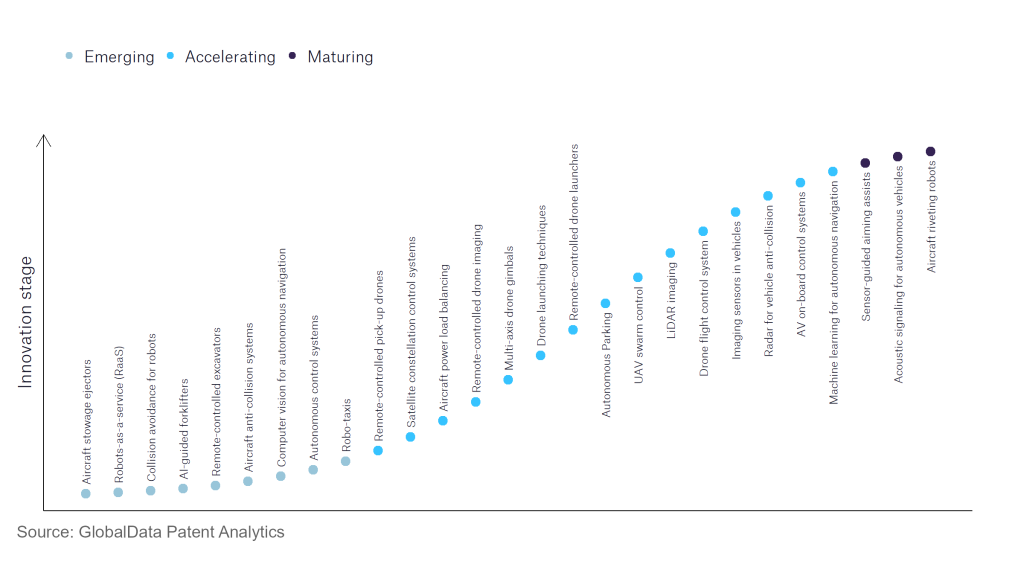The aerospace and defence industry continues to be a hotbed of innovation, with the conflict in Ukraine driving defence spending and investment, the need to combat emerging technologies such as hypersonics, and growing importance of technologies such as AI and computer vision. In the last three years alone, there have been over 174,000 patents filed and granted in the aerospace and defence industry, according to GlobalData’s report on Robotics in Aerospace, Defence & Security: UAV swarm control. Buy the report here.
However, not all innovations are equal and nor do they follow a constant upward trend. Instead, their evolution takes the form of an S-shaped curve that reflects their typical lifecycle from early emergence to accelerating adoption, before finally stabilising and reaching maturity.
Identifying where a particular innovation is on this journey, especially those that are in the emerging and accelerating stages, is essential for understanding their current level of adoption and the likely future trajectory and impact they will have.
180+ innovations will shape the aerospace and defence industry
According to GlobalData’s Technology Foresights, which plots the S-curve for the aerospace and defence industry using innovation intensity models built on over 262,000 patents, there are 180+ innovation areas that will shape the future of the industry.
Within the emerging innovation stage, collision avoidance for robotics, computer vision for autonomous navigation and autonomous control systems are disruptive technologies that are in the early stages of application and should be tracked closely. Remote-controlled pick-up drones, satellite constellation control systems and imaging sensors in vehicles are some of the accelerating innovation areas, where adoption has been steadily increasing. Among maturing innovation areas are sensor-guided aiming assists and acoustic signalling for autonomous vehicles, which are now well established in the industry.
Innovation S-curve for robotics in the aerospace and defence industry

UAV swarm control is a key innovation area in robotics
A drone swarm is a network of drones controlled either by a remote operator or autonomously using internal processors.
GlobalData’s analysis also uncovers the companies at the forefront of each innovation area and assesses the potential reach and impact of their patenting activity across different applications and geographies. According to GlobalData, there are 20+ companies, spanning technology vendors, established aerospace and defence companies, and up-and-coming start-ups engaged in the development and application of UAV swarm control.
Key players in UAV swarm control – a disruptive innovation in the aerospace and defence industry
‘Application diversity’ measures the number of different applications identified for each relevant patent and broadly splits companies into either ‘niche’ or ‘diversified’ innovators.
‘Geographic reach’ refers to the number of different countries each relevant patent is registered in and reflects the breadth of geographic application intended, ranging from ‘global’ to ‘local’.
Patent volumes related to UAV swarm control
| Company | Total patents (2021 - 2023) | Premium intelligence on the world's largest companies |
| Intel | 65 | Unlock Company Profile |
| Tevel Aerobotics Technologies | 43 | Unlock Company Profile |
| Boeing | 34 | Unlock Company Profile |
| Proxy Technologies | 31 | Unlock Company Profile |
| Sony Group | 19 | Unlock Company Profile |
| Genghiscomm Holdings | 18 | Unlock Company Profile |
| SoftBank Group | 17 | Unlock Company Profile |
| Amazon.com | 17 | Unlock Company Profile |
| Sunlight Photonics | 14 | Unlock Company Profile |
| Kitty Hawk | 12 | Unlock Company Profile |
| Walmart | 12 | Unlock Company Profile |
| Donecle | 12 | Unlock Company Profile |
| SZ DJI Technology | 11 | Unlock Company Profile |
| Thales | 10 | Unlock Company Profile |
| Israel Aerospace Industries | 8 | Unlock Company Profile |
| Liebherr-International | 8 | Unlock Company Profile |
| Telefonaktiebolaget LM Ericsson | 7 | Unlock Company Profile |
| PABLO AIR | 6 | Unlock Company Profile |
| AeroVironment | 6 | Unlock Company Profile |
| Robotic Research | 6 | Unlock Company Profile |
| JD.com | 6 | Unlock Company Profile |
| Panasonic | 6 | Unlock Company Profile |
| Intellectual Ventures Management | 6 | Unlock Company Profile |
| vHive Tech | 5 | Unlock Company Profile |
| Rakuten Group | 5 | Unlock Company Profile |
| Microsoft | 5 | Unlock Company Profile |
| Infinium Robotics | 5 | Unlock Company Profile |
Source: GlobalData Patent Analytics
Intel is one of the leading patent filers in UAV swarm control. The company has developed the technology for use in light shows as well as other commercial applications. Tevel Aerobotics Technologies is the second largest patent filer in UAV swarm control and has also developed the technology for commercial uses including agriculture. Boeing has developed UAV swarm control for military applications, using ScanEagle UAVs and a single operator – though the technology is still in the demonstration phase.
In terms of application diversity, Robotic Research is the largest company, while Israel Aerospace Industries and Sony Group are in second and third positions, respectively. By geographic reach, Tevel Aerobotics Technologies is the top company, followed by Donecle and Israel Aerospace Industries.
Whilst many of the existing patent filings are commercial, the technology has significant military applications and investment by companies including Boeing and Israel Aerospace Industries demonstrates this.
To further understand the key themes and technologies disrupting the aerospace and defence industry, access GlobalData’s latest thematic research report on Defence.
Data Insights
From

The gold standard of business intelligence.
Blending expert knowledge with cutting-edge technology, GlobalData’s unrivalled proprietary data will enable you to decode what’s happening in your market. You can make better informed decisions and gain a future-proof advantage over your competitors.



